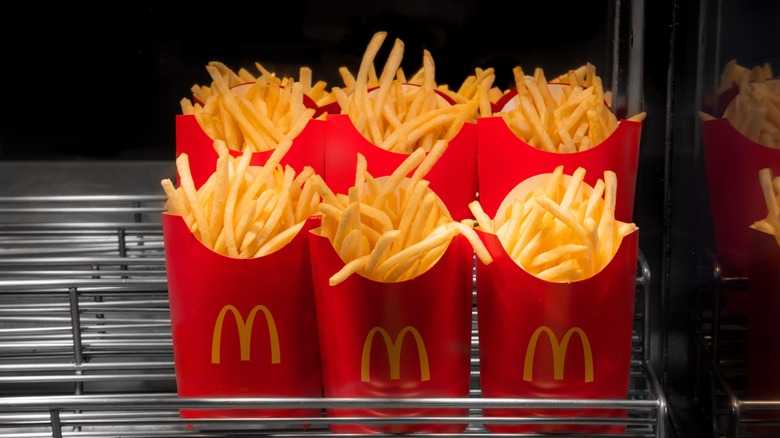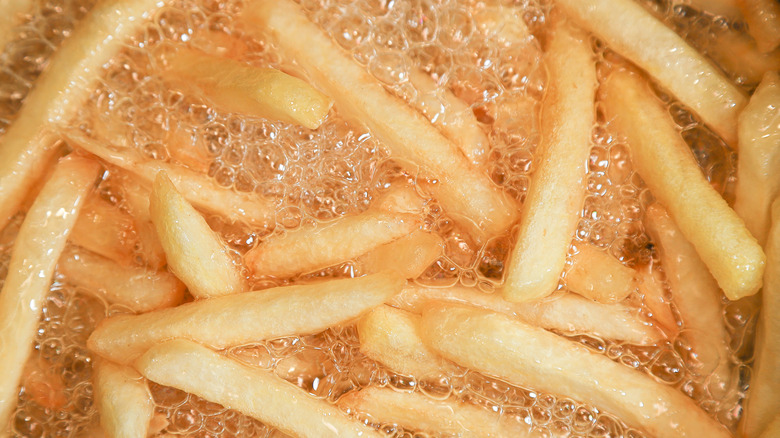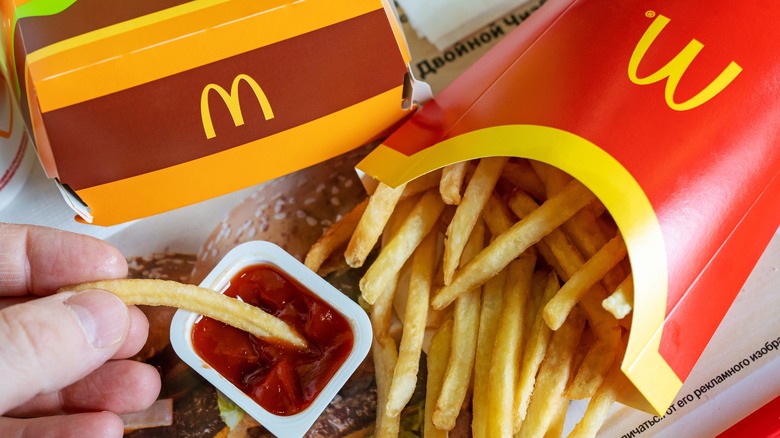The Secret Ingredient That Makes McDonald's Fry Oil So Flavorful
McDonald's has perfected fast food. Each day the restaurant chain produces some of the tastiest pours of soda (the Sprite is practically electric), most iconic burgers, and some seriously mouthwatering french fries. Even among McDonald's skeptics, opinions on the chain's french fries are overwhelmingly positive. The fries have also gained a global following, complete with an array of unique fry offerings in many countries. Each fry is perfectly salted and has a unique flavor that is unmatched by other, competing chains. So what's the secret behind McDonald's french fries? Beef flavoring. Yes, McDonald's spuds are flavored with more than just salt and oil. The chain actually adds in beef flavoring to its fry oil in order to produce a richer flavor.
This is done in order to replicate the chain's original fry recipe, which used beef tallow rather than vegetable oil for frying. This beef tallow gave the fries a perfect crunchy exterior, pillowy interior, and a rich and distinctive flavor that set it apart from other restaurant fries. However, due to health reasons, the use of beef tallow ceased in the 1990s. Tallow was replaced with vegetable oil, and beef flavoring was later added to the recipe in order to produce a tastier fry. Those who recall the original fry recipe can spot the difference in its current iteration. However, its fries do well in replicating the original, beefy taste, and eating a few "bag fries" on the way home is still standard practice.
An oil once tallow
So why did McDonald's switch up its oil from beef to vegetable? It starts with one man's pursuit of a healthier fry. Phil Sokolof, a wealthy businessman, suffered from a heart attack at the age of 43 in 1966. Following his heart attack, Sokolof founded the National Heart Savers Association, which sought to prevent the sale of foods high in saturated fats, to decrease the chance of increasing one's cholesterol levels. One of Sokolof's primary targets was the famously fatty McDonald's french fry. In 1990, Sokolof won the french fry war, and McDonald's replaced its tallow frying oil with vegetable oil.
However, many diners found this oil replacement lacking in the flavor and texture department, so beef flavoring was added in. The use of hydrogenated vegetable oil, which was the replacement to beef tallow, was later found to also be hazardous to health, so the recipe was once again changed in 2007. However, the added beef flavor remained present. And though those who remember the original recipe may still mourn its rich flavor, the fries still maintain at least a shade of the original charm. If you find yourself missing the taste of beef tallow, you can always incorporate it into your own recipes. The rich flavor of beef tallow makes a great addition to a steak dinner, just ask the famous Delmonico's steakhouse.
More than just a beefy secret
Now, the beef flavoring that is added to McDonald's oil does give its fries a distinct taste that sets them apart from other fast food fries. But beef flavoring isn't McDonald's only secret ingredient. There is a very specific reason why you can't seem to wait until you get home to dig into your container of fries. Many of McDonald's foods, but especially its fries, are perfectly formulated to hit consumers' "bliss point," which is a specific balance of ingredients and flavors which, when combined, create an infinitely crave-worthy food. Bliss point foods have a combination of sweet, salty, and fatty (or rich) flavors that keep diners coming back for more.
You may be wondering how McDonald's fries incorporate the sweet aspect to its recipe. After all, the fries aren't exactly sugary. However, McDonald's french fries actually do incorporate sugar into the recipe. The fries are coated in dextrose prior to frying. Dextrose is a type of sugar that comes from corn (or maize). However, this coating doesn't make its fries sweet. Rather, it helps the fries to reach a nice, golden shade when frying, and ensures a perfectly crispy exterior. All of these aspects combine to create one downright perfect fast food treat, one which has endured the test of time (and multiple recipe revisions).


